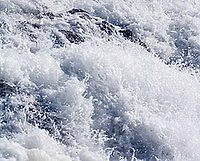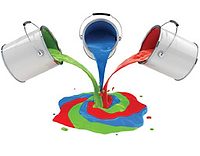Novel, Environmentally Friendly Corrosion Inhibitor for Self-Etching Wash Primers

Introduction
In the automobile refinishing and industrial manufacturing industries, and where untreated or bare metal is painted, an etch primer is typically used to increase adhesion of the paint to the metal surface and to improve the anticorrosive quality of the coating. Historically, etch primers have utilized zinc tetraoxy chromate as the primary corrosion inhibitor. However due to the toxicity and carcinogenic concerns associated with chromates, as well as the dawning of the new era of “green regulations”, an environmentally friendly alternative is needed for this market.
Zinc phosphate corrosion inhibitors have been studied as a replacement for zinc tetraoxy chromate in this type of application, and they have seen limited success. Historically, zinc phosphate has exhibited similar performance to chromates in real-world outside exposure. However, in harsher conditions such as marine environments and accelerated salt spray or prohesion testing, the results are less favorable; however, it is important to note that under these more harsh conditions, zinc phosphate still helps in the preservation of the metal substrate, just not to the degree the chromate presents. Even though zinc is not considered a heavy metal, it is still a requirement to report its use.
Etch primers are traditionally formulated with phosphoric acid and zinc tetraoxy chromate in an alcohol medium, using polyvinyl butyral as the binder, which acts as a ligand of the reaction products. As new global environmental standards are put in place, stricter formulation guidelines will become prevalent. In the near future a push to lower VOCs and HAPS-free systems, to eliminate chrome, to limit reportable compounds, and to develop water-based hybrids are in store for the etch-primer market.
The objective of the work presented herein was to develop a chrome-free self-etching primer that meets current and future global environmental demands, as well as offer improved performance over an existing chrome-free formula utilizing zinc phosphate and comparable to improved results to an industry-standard zinc tetraoxy chromate-containing etch primer. A range of Nubirox corrosion inhibitors were evaluated in this study in order to determine which chrome-free inhibitor showed the best results.

|
| Figure 1 Click to enlarge |
Project Design
The formulations were based on an epoxy/phenolic-modified polyvinyl butyral (PVB) system. The pigment volume concentration (PVC) of each formulation was held constant at 12%, and the PVC/CPVC ratio remained at 0.29. Four Nubirox inhibitors, and combinations thereof, were evaluated at different levels in order to determine which gave the most advantageous results. In all, there were 10 experimental data points evaluated, along with two controls (a commercially available zinc tetraoxy chromate-containing (5.5% by total formula weight) self-etching wash primer along with one that is chrome-free and utilizes zinc phosphate (5% by total formula weight)). The four Nubirox inhibitors evaluated were:
- Nubirox N2 – standard zinc phosphate;
- Nubirox 106 –molybdate-modified zinc phosphate;
- Nubirox 213 – multiphase iron and zinc phosphate; and
- Nubirox 301 – calcium and strontium phosphosilicate; along with a 1:1 ratio of combinations of the following inhibitors:
- Nubirox 213 : Nubirox 106;
- Nubirox 213 : Nubirox 301; and
- Nubirox 106 : Nubirox 301.
The inhibitors were evaluated at two loading levels, 1.5% total formula weight (t.f.w.) and 3.0% t.f.w. – with the exception of the Nubirox N2, which was only evaluated at 1.5% t.f.w. Each combination of inhibitors was evaluated at the loading of 1.5% t.f.w. per inhibitor.
The formulations were evaluated over three types of substrates – galvanized steel, cold rolled steel and aluminum. A total of 432 panels were coated via spray application using a HVLP (high-volume low-pressure) spray gun. The top half of each panel showed the self-etching primer alone, and the lower half showed the etch primer along with a commercially available intermediate sanding primer. One panel for each test was also sprayed with a commercially available acrylic topcoat.
Characterization of the film formed by the etch-primer formulations was done via Electro-Impedance Spectroscopy (EIS, see Figure 1) and SEM/EDX analysis.
The panels were allowed to rest for 7 days before corrosion testing began. They were then evaluated to assess blistering, rusting and adhesion via accelerated ASTM D 4585 humidity testing, ASTM B-117 salt spray testing, as well as ASTM D 5894 cyclic QUV/prohesion testing. Each test contained three replicates of each experimental and of each control – one topcoat along with two etch/etch-intermediate panels.
The ASTM D 4585 humidity testing was conducted for a set 94 hours; however, in the other tests the panels were periodically evaluated and when enough differential was seen among all the experiments as well as the controls, the panels were removed from test, the middle portion of the film was stripped, and the metal beneath the film was then evaluated via ASTM D 610 for panel corrosion, ASTM D 1654 for scribe corrosion and ASTM D 714 for panel/scribe blister.
Results

|
| Figure 2 Click to enlarge |
The EIS values from the highest performance formulations can be seen in Figure 2. As can be seen, Nubirox 301 at 3% by t.f.w. (shown as Exp 2 denoted by red circles) exhibited similar trend in impedance values as that of zinc tetraoxy chromate (shown as control denoted by green triangles). The remaining experiments denoted on the chart are as follows: Exp. 1 Nubirox 106 at 1.5% by t.f.w., Exp. 3 Nubirox 213 at 3% by t.f.w., and Exp. 4 Nubirox N2 at 1.5% by t.f.w.
SEM-EDX is the name of the energy-dispersive X-ray spectroscopy analysis conducted by means of scanning electron microscopy. It is an analytical technique used to determine the chemical composition of a given specimen as well as its morphology and structure. SEM-EDX analysis was employed in this study for mapping quantitative and qualitative oxidation generation on the surface of the various substrates.

|
| Figure 3 Click to enlarge |
The pictorial results from the SEM/EDX analysis are shown below in Figure 3. As with the EIS values, the results from this analysis show that the Nubirox 301 at 3% by t.f.w. is most comparable to the 5.5% by t.f.w. zinc tetraoxy chromate. Exp. 1-4 shown are the same from the EIS evaluation; Exp 5-7 are the 1:1 blends.
In accelerated corrosion testing, overall the best results were seen with the addition of Nubirox 301 at 3.0% t.f.w. Nubirox 301, in both salt spray and prohesion tests and on all substrates, showed better adhesion promotion, less field corrosion, and comparable to improved scribe rust inhibition in comparison to the control utilizing 5% by t.f.w. standard zinc phosphate.

|
| Figure 4 Click to enlarge |
Nubirox 301 at 3.0% t.f.w. also had comparable to improved results to the etch primer containing 5.5% by t.f.w. zinc tetraoxy chromate (Figures 4 and 5). The salt spray (ASTM B 117) testing was pulled after 309 hours, and the cyclic QUV/prohesion (ASTM D 5894) testing was pulled after 537 hours.
Additional testing was conducted using a slightly different 2K self-etching wash primer. These results (Figure 6) also show Nubirox 301 having advantageous results when compared to zinc tetraoxy chromate in both the ASTM B 117 and the ASTM D 5894 testing on cold rolled and galvanized steel. These additional pictorial results show the etch primer alone – with no intermediate primer.
As stated previously, each panel was rated via ASTM D 610 for panel corrosion, ASTM D 1654 for scribe corrosion, and ASTM D 714 for panel/scribe blister.
Tables 1 through 6 give the detailed ratings of the experiments that exhibited the best results (correlating pictorial results from Figures 4 and 5).
The blister ratings are as follows: F (for few), M (for medium), MD (for medium dense) and D (for dense) – along with a number to designate the percent of area affected.
The field rust rating ranges from 10 (being no area affected) to 0 (being over 50 percent rusted).
The scribe rust rating ranges from 10 (being no rust from scribe) to 0 (being over 16 mm rust from scribe).
Each of these rating scales is directly taken from the respective ASTM.

|
| Figure 5 Click to enlarge |
Summary
It is apparent by both the pictorial results and the ASTM evaluations that Nubirox 301 presents a favorable alternative to chrome in a 2K epoxy/phenolic PVB etch primer system. The results show that Nubirox 301 shows overall comparable results to zinc chromate in this system, and in most cases out-performs standard zinc phosphate, which is the current alternative.
Nubirox 301, an “eco-friendly” zinc-free corrosion inhibitor, meets both the ever increasing and limiting environmental demands, as well as the performance requirements needed for this type of application. Nubirox 301 is a calcium and strontium phosphate complex carried on a silicate core. The calcium and strontium cations provide direct anodic inhibition, where the silica-core alkalinity provides good cathodic inhibition. This chemical composition works within the etch-primer formulation and reacts with the phosphoric acid to form the passive layer seen in Figure 7.
In addition to the chemical activity of this corrosion inhibitor, Nubirox 301 has a unique particle morphology, a fine mean particle size, along with a narrow particle size distribution (Figure 8) – thus providing more uniform pigment packing, which allows for excellent thin-film performance. This is ideal for the etch primer market, seeing that the primer is typically applied at less than 1 mil (25 µ) dry film thickness. It also lends to the excellent package stability found with Nubirox 301 in this system.

|
| Figure 6 Click to enlarge |
Conclusions
-
Nubirox 301 at an addition of 3.0% t.f.w. in a 2K epoxy/phenolic-modified PVB self-etching wash primer showed comparable results vs. a commercially available zinc tetraoxy chromate-containing etch primer.

Figure 7 Click to enlarge - Nubirox 301 (zinc-free) was the most effective non-chrome inhibitor for multi-substrates.
- Nubirox 301 is a calcium and strontium phosphate complex carried on a silicate core; therefore, it is not only chrome-free, it is zinc-free as well. Thus it is the most eco-friendly alternative available. There are no components of this inhibitor that are required to be reported.
- The fine particle size of Nubirox 301 is ideal for thin film systems such as etch primers.
Acknowledgements
- Nathan Karszes, Laboratory Manager, Nubiola North American Technology Center.
- Richard March Raurell, R&D Manager, Nubiola Spain.
Looking for a reprint of this article?
From high-res PDFs to custom plaques, order your copy today!








